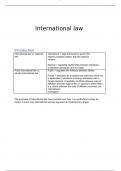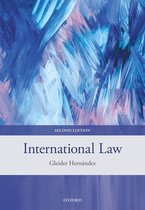lOMoARcPSD|5716693
International law
Introduction
International law vs. National International = legal framework to govern the
law relations between States, the law between
nations.
National = regulating relationships between individuals
or between individuals and the State.
Public international law vs. Public = regulates the relations between States
private international law
Private = describes the principles that determine which law
is applicable to situations involving individuals with a
foreign element. It regulates conflicts between rules of
different domestic legal orders in situations where there
is a choice between the laws of different countries. (ex.
international
marriages)
The purposes of international law have evolved over time. It is worthwhile to study its
history to know how international law has assumed its contemporary shape.
, lOMoARcPSD|5716693
1. A Brief History of International Law
For as long as organized societies have existed, different societies have interacted with each other
since immemorial time. Over time rules have developed to regulate their relations with one another.
↳ they have signed treaties (verdragen) of alliance and even exchanged diplomats.
There are early records across the world of these interactions between societies. The earlies
surviving treaty text was agreed between an Egyptian pharaoh and Hittite King. We also have
remains of Roman peace treaties.
In mediaeval Western Europe, after the fall of the Roman Empire, there existed a patchwork of
feudal entities and kingdoms. Over time feudal arrangements made place for centralized structures,
which began to take on the characteristics of a State.
After the Protestant Reformation in central and northern Europe, in which Calvin and Luther
denounced the ecclesiastical structure of the Roman Catholic Church and papal supremacy
(stelden dit in vraag), a number of religious wars plagued Europe (Europa,werd geplaagd door
godsienstoorlogen), culminating in the 30 years war (1618-1648). These were terminated
with the Peace of Westphalia, the name of several treaties signed in 1648 and which marks
the start of modern international law.
Europe took over the world for 500 years (1492-1914) in terms of power and in terms of war .
So the law of the European countries was seen as the standard and other countries had to
adhere to it to be accepted as international legal actors. That’s why IL is so euro-centric.
=> Euro‐centric international law today has roots in European expansion from 1492‐1914
Intellectual traditions that existed before 1500 => ideas that organised the debate on how the world
should be organised
- Aristotle => idea of kosmopolis = the idea of a polis, a political community.
Aristotle’s idea was that we could have all the people of the world under one polis,
under one government. So a universal government that could set rules for the entire
world. This idea was adopted by the Christian church => we are all united
under the kingdom of God + transformed in jus naturele
- Ius gentium (law of peoples)=> the idea that people organised themself into
smaller communities. Before 1500, that idea was not very important, the church was
utter dominant in Europe and it had the capacity to remove kings and queens, to
force unification between different territories etc. There was this sense that under ius
naturale (the law of nature) one universal community of Christian people needed to be
formed. So ius gentium was quite marginalised during this period.
During this period, there was not a lot of concentrated thinking about government
and democracy was not a thing yet. Nevertheless, in Italy we see the beginning of what we
would call international law today. Back then, Italy was not one country, you had several
kingdoms
=> those kingdoms were trading with each other, exchanging ambassadors, recognizing
the power of each other’s king, duke, pope etc. and they were developing rules
between them. These are the murmurs (=’ruis’) of modern international law.
, lOMoARcPSD|5716693
1. The origins of modern international law
1.1 Peace of Westphalia
Westphalia is understood as the starting-point for modern IL in Europe. The peace of
Westphalia represented a definitive rejection of the secular power of the Pope over the
internal affairs of other States. States would henceforth (zouden voortaan) be sovereign and
equal in their relations with one another without external interference unless consent was
expressly given. (sovereignty was affirmed)
Westphalia was the seed of a decisive move away from a universal law rooted (geworteld) in the
Christian religion
=> so the sense of jus naturale weakened. We can even speak about a rebirth of ius gentium.
Also, under the Peace of Westphalia, each State (in those times, all the thousands of small
entities which made up Western-Europe), would be free to choose for itself which religion to
adopt: cuius regio eius religio.
We see clearly that the treaties of Westphalia were not only designed to end the war but
also to establish the basis for future relations.
1.2 Grotius, jus naturale and jus gentium
Hugo de Groot was a lawyer based in Leiden. His lasting contribution (blijvende bijdrage) was
in his depiction of the nature of international law (beschrijving v/d aard van int recht)
In his book On the law of War and Peace, he portrayed IL as a combination of 2 distinct
bodies: jus gentium and jus naturale.
- Ius naturale was the law that existed within nature, these laws were universal, eternal and
would be discovered through the full use of human reasoning
- Ius gentium was a purely human creation, subject to change from time to time, and variable
from place to place. Its source validity (geldigheid v/d bron) was the consent of States.
This idea was taken up by Wolff, Pufendorf and Kant but rejected by Vattel who focused only on
relevance of ius gentium.
Characteristics of the jus gentium:
- IL is based on the sovereign equality of States => all states in the international legal
order are considered equal and sovereign => they are capable of making their own
decisions.
- IL is a voluntary system based on consent => States consent to an obligation => only if
they consent, they are bound => they can make this decision because they are
sovereign.
- States only make rules horizontally in the international legal order =>
o In the Belgian legal order, Parliament passes laws and they bind all citizens
and all residences => vertical system => up-down
o Horizontal system = system where all the legal subjects make the law together. So in
the international legal order States create the law that applies between them.
There is no superior authority that stands above them.
- The triumph of ius gentium means the rejection of natural justice => law is what States
made.
- Yet this facilitated (vergemakkelijkte) European colonialism and in the 18th and 19th
century this gave rise to the civilising mission => the idea that Europe had the best way of
governing and the best legal rules and that it was our duty to give the rest of the world
our system.
, lOMoARcPSD|5716693
- This way of thinking gave rise to positivism => the idea that legal rules are created by
human beings through processes





